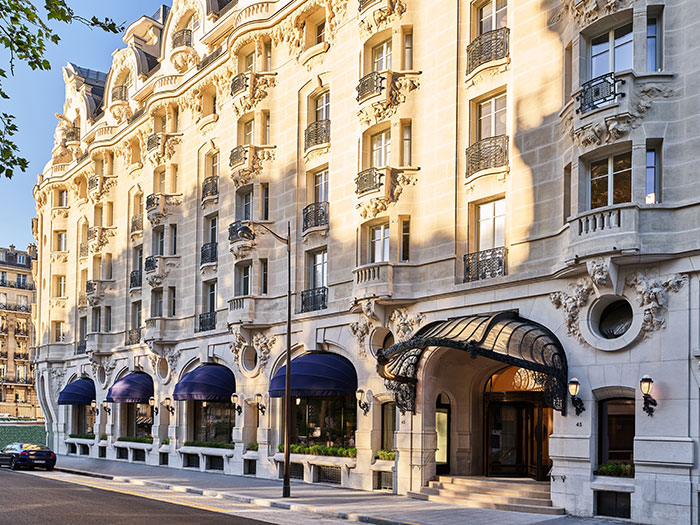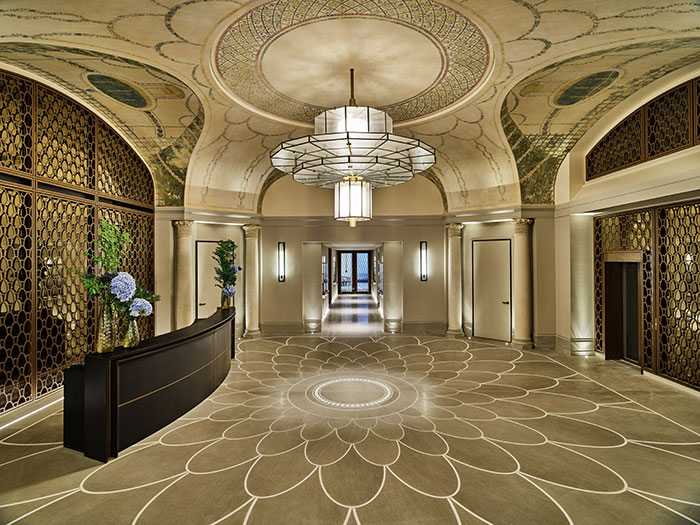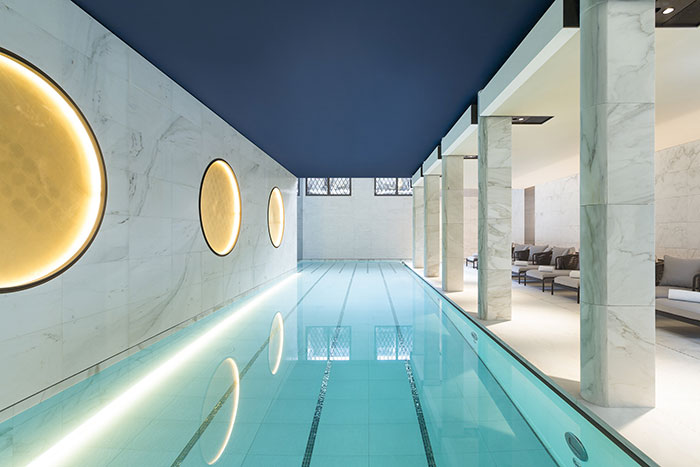The Hotel Lutetia, a piece of Parisian history

Roula Khalaf, Editor of the FT, selects her favourite stories in this weekly newsletter.
At the newly renovated Hotel Lutetia, which looms like a white ocean liner over the Boulevard Raspail on Paris’s Left Bank, there is a plaque. It reads: “From April to August 1945, this hotel, which had become a reception centre, received the greater part of the survivors of the Nazi concentration camps, glad to have regained their liberty and their loved ones from whom they had been snatched. Their joy cannot efface the anguish and the pain of the families of the thousands of disappeared who waited in vain for their own in this place.”
Among those who waited in vain were two sisters, one an adolescent, the other a little girl. They were the daughters of Irène Némirovsky, whose novel Suite Française was published posthumously in 2004. Pierre Assouline describes the scene in his own novel Lutetia, which is set in the hotel during the second world war. A waiter tells the narrator, a detective in charge of hotel security, how the sisters would wait on the steps of the Lutetia, holding handwritten signs, in the hope of finding their mother. “They came to look at the lists [of returning deportees] every day. They said their mother was a famous novelist. They had convinced themselves that if she hadn’t come back it was because she had lost her memory and was in a hospital somewhere in Russia . . . But there was no chance of seeing her again. None.”
As Assouline has put it, the Lutetia is “not just any grand hotel. It is a site of memory for many French people.” Isabelle Bouvier, the manager of the hotel, which reopened its doors in July after a four-year renovation, agrees. It was “always a mirror of what was happening in the world”, she says. It received Russian refugees fleeing the revolution in 1917 and then, in the early 1930s, German Jews escaping the Third Reich.
Bouvier says that the task of the architect, Jean-Michel Wilmotte, was to restore the “soul” of the Lutetia, paying due deference to its extraordinary history while also making it fit for the 21st century and re-establishing it as the only “grand hotel” (a luxury property) on the Left Bank.
Assouline, who has become a kind of unofficial historian of the Lutetia, wrote recently: “When you love the Lutetia as if it were a person, it is hard to fight off a certain nostalgia at its reawakening.” Before Wilmotte started work in 2014, he confessed that the hotel bar was his “salon and office”. And it is hard, even for a visitor, rather than a devotee such as Assouline, not to feel the breath of history around every corner.
And this is despite the introduction of international hotel vernacular into the Art Deco and Art Nouveau interior. Wilmotte has chosen marble — great expanses of it — for the public areas on the ground floor, while the corridors on the upper floors are clad in dark eucalyptus wood. The effect of the latter is slightly claustrophobic. Initially, I found myself almost feeling my way along the walls when trying to negotiate the few steps from my suite to the lift.
One of the historical figures guests might be reminded of is Charles de Gaulle, holed up in the Lutetia in early June 1940, as German forces bore down on Paris. De Gaulle had been a regular in the salon and dining room before the war. He banked at the branch of the Banque de France across the road and was rumoured to have spent his wedding night in the hotel. He would have rubbed shoulders in that prewar period with the Left Bank’s literary demi-monde. The writer and aviator Antoine de Saint-Exupéry was a regular guest, as was James Joyce, who played Irish ballads on the piano in the bar. The night I met a friend for cocktails in the Bar Josephine, named after the Franco-American performer Josephine Baker, young musicians were doing a very passable impression of the Quintette du Hot Club de France.
The Lutetia remained a favourite meeting place for literary Paris after the war. Many of the big publishing houses, notably Gallimard and Grasset, are nearby in Saint-Germain-des-Prés. The hotel has also doubled as an office for academics from the Ecole des Hautes Etudes en Sciences Sociales just down the road. I remember, when I was a student there in the mid-1990s, the philosopher Jacques Derrida holding court in the Lutetia bar on more than one occasion.
On the evening of June 10 1940, de Gaulle was summoned by a gendarme who told him that a car was waiting outside the hotel to take him to a château near Tours in the Loire, where the prime minister Paul Reynaud and other members of the government had sought refuge. According to Assouline, who talked to several people who’d worked in the Lutetia at the time, the general insisted on settling his bill before leaving.
The Germans reached Paris on June 14. For the next four years, the Lutetia, like the other grand hotels in the city, was requisitioned by the occupying power. It became the headquarters of the Abwehr, the German counter-intelligence service, not the Gestapo as is sometimes mistakenly believed. (Among the palace hotels of the Right Bank, the Crillon became the headquarters of the military command for greater Paris; the top brass installed themselves at the Georges V; and the Continental was home to the military tribunal.)

Assouline says that there is something “profoundly unjust” about the reputation that the Lutetia had during these dark years. It wasn’t the only hotel in Paris to be taken over by the Germans, after all, but it was the only one to find “redemption” after the war. It was de Gaulle who decreed in 1945 that the returning deportees should be received at the Lutetia, on account of its being “luxurious yet sober”, a description that could easily be applied to the hotel today, with the subtle blue and grey colour scheme and polished parquet in the rooms, and service that is discreetly attentive rather than obsequious.
Concentrating on the dark years also obscures the story of the hotel’s origins, a tale that goes some way to explaining one of its distinctive features compared with its competitors on the Right Bank: that, as Bouvier puts it, “you have always found Parisians at the Lutetia”. And if the queue of locals waiting to get in to the bar on the Saturday night I was there is anything to go by, that’s still the case.
The Lutetia was the brainchild of the Boucicauts, owners of Le Bon Marché department store in the 7th arrondissement. In the early 20th century, they noticed the bulk of their clientele were families from the provincial bourgeoisie, who would come to the capital twice a year to stock up on sheets and kitchen utensils. Why not offer these visitors somewhere to stay close to the store?
The hotel opened in December 1910, on a site across the Boulevard Raspail from Le Bon Marché. The architects were Henri Tauzin and Louis-Hippolyte Boileau, who used the latest glass-and-steel construction techniques. Soon the hotel was a regular destination not only for customers at Le Bon Marché, but also members of the National Assembly, a shortish walk away, and civil servants in the colonial service who traditionally spent summer holidays in Paris.
The hotel passed into the hands of the Taittinger champagne family in the 1950s (Taittinger’s Cuvée Lutetia is still served in the bar and restaurants), before being sold to the Starwood Capital Group in 2005. Starwood sold out to the current owner, hotel brand The Set, in 2010. It was The Set’s chairman Georgi Akirov, an Israeli, who hired Wilmotte to oversee the renovation.
For the most part, the overhaul has been a success. Bouvier tells me they intend to compete with the “palaces” on the Right Bank. So to that end, Wilmotte has equipped the Lutetia with all the trappings today’s international traveller expects — the basement was dug out to create space for a 700 sq metre spa, a swimming pool and a gym. At the same time, he has remained broadly faithful to Tauzin and Boileau’s original vision. The most spectacular example of this is in the bar, where an original Art Deco fresco has been beautifully restored. Elsewhere, he has opened up communal spaces allowing in natural light through judicious use of glass and steel.

The revamp is still unfinished. I stayed in a generously proportioned suite with a living room, bedroom and bathroom on the fourth floor looking out over Boulevard Raspail. The larger, more expensive suites on the upper floors, with spectacular views across Paris, will open in autumn, as will Gérald Passedat’s Brasserie Lutetia. Passedat, who elsewhere holds three Michelin stars, is promising to bring the seafood-based cuisine of his native Marseille to Paris. For the time being, guests have the option of eating under the lovingly restored original glass roof of Le Saint Germain, where chef Benjamin Brial offers an elegant fusion of traditional French dishes (tartare de boeuf, entrecôte and so on) with embellishments from the Pacific Rim.
“Whoever owns the Lutetia,” Assouline wrote when the hotel reopened, “is the custodian of a tradition.” Happily, Akirov and Wilmotte seem to have understood that.
Details
The writer was a guest of the hotel. Rooms from €850; hotellutetia.com
Follow @FTLifeArts on Twitter to find out about our latest stories first. Subscribe to FT Life on YouTube for the latest FT Weekend videos
Comments